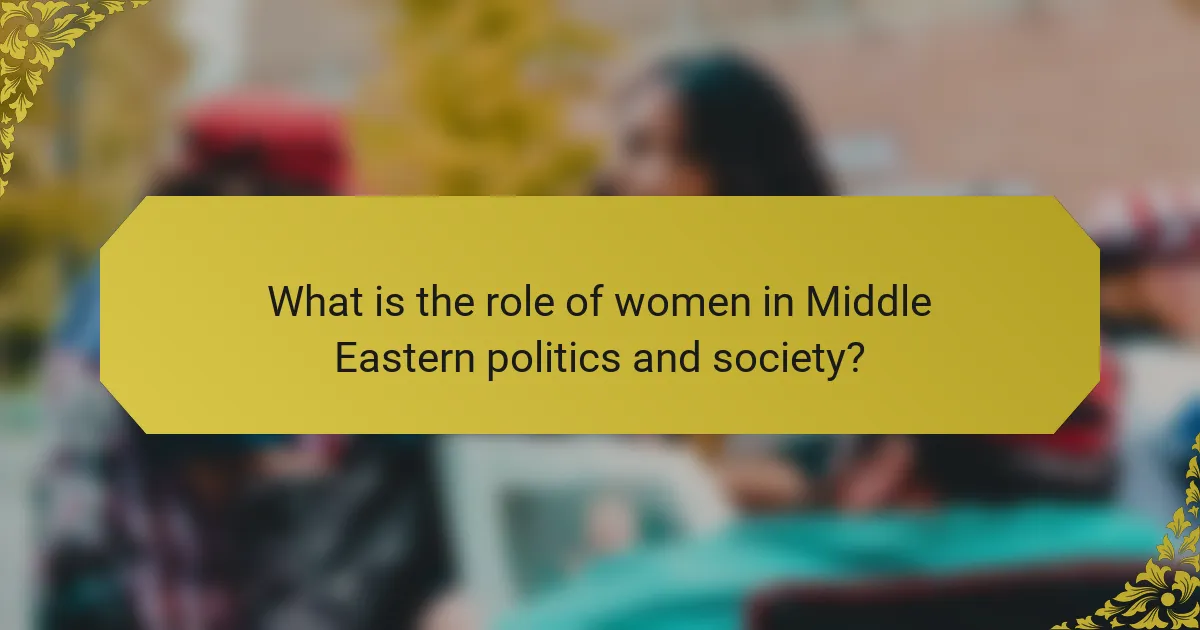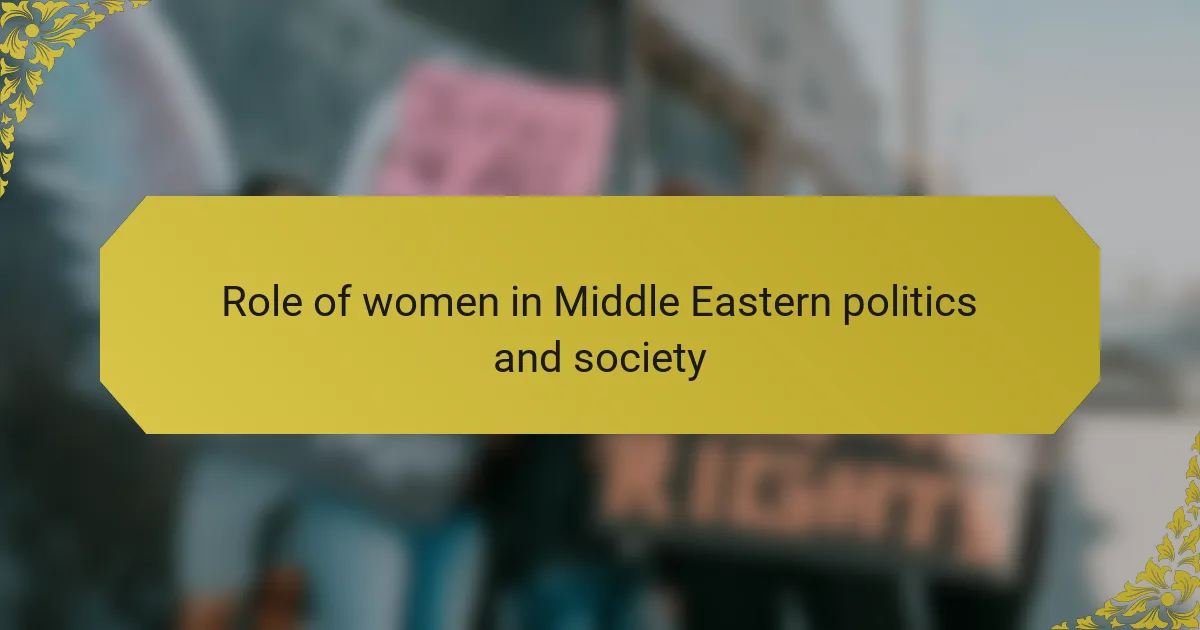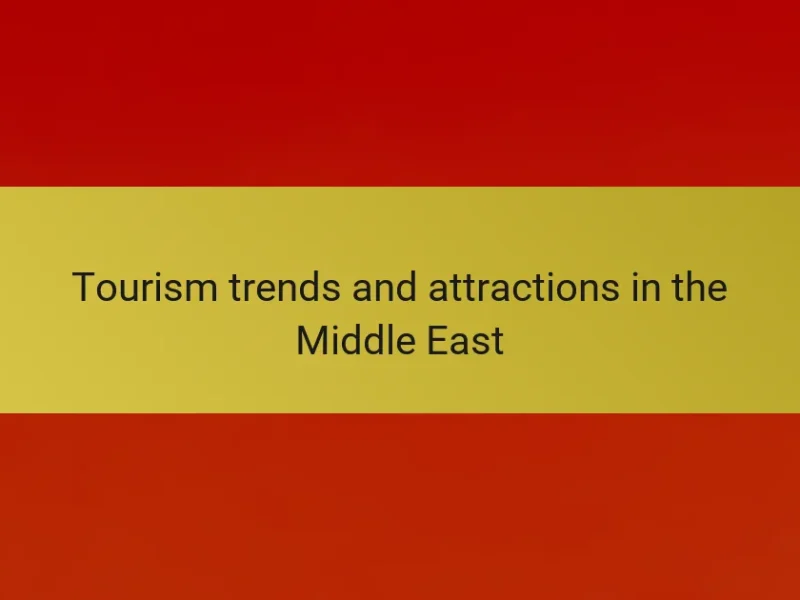
What is the role of women in Middle Eastern politics and society?
Women in Middle Eastern politics and society play increasingly significant roles. They participate in various capacities, including political leadership and activism. In countries like Tunisia, women hold a substantial percentage of parliamentary seats. For instance, as of 2020, women comprised 47% of the Tunisian parliament. In Saudi Arabia, women gained the right to vote and run for office in 2015, marking a historic change. Women’s rights movements have emerged across the region, advocating for gender equality and social reforms. Despite challenges, women continue to influence social policies and cultural norms. Their contributions are essential for the region’s development and modernization.
How has the historical context shaped women’s roles in the region?
Historical context has significantly shaped women’s roles in the Middle East. Traditional patriarchal structures have often limited women’s rights and opportunities. Colonialism introduced new dynamics that affected gender roles. Post-colonial movements sometimes empowered women through education and activism. Wars and conflicts have also influenced women’s participation in the workforce. For example, during the Gulf War, many women took on roles traditionally held by men. Recent movements for gender equality have emerged in response to historical oppression. These movements aim to redefine women’s positions in both politics and society. Overall, historical events have created a complex landscape for women’s roles in the region.
What significant events have influenced women’s political participation?
Significant events that have influenced women’s political participation include the suffrage movements in the early 20th century. These movements led to women gaining the right to vote in several countries. For example, women in Egypt were granted suffrage in 1956. The Arab Spring in 2011 also played a crucial role. It mobilized women to demand political rights and representation. Women’s participation in protests highlighted their political agency. Additionally, international agreements like the Convention on the Elimination of All Forms of Discrimination Against Women (CEDAW) have encouraged countries to improve women’s political involvement. These events collectively shaped the landscape of women’s political participation in the Middle East.
How have cultural norms impacted women’s societal roles?
Cultural norms have significantly shaped women’s societal roles in the Middle East. These norms often dictate expectations regarding women’s behavior, education, and employment. Traditional views frequently prioritize domestic responsibilities over professional aspirations for women. In many societies, women are expected to fulfill roles as caregivers and homemakers. This has limited their participation in public life and decision-making processes. For instance, in countries like Saudi Arabia, women gained the right to drive only in 2018, reflecting gradual shifts in cultural attitudes. Furthermore, cultural norms can reinforce legal frameworks that restrict women’s rights. As a result, women’s societal roles are often defined by a complex interplay of tradition and modernity. This dynamic continues to evolve as more women advocate for their rights and seek greater participation in various sectors.
What are the current challenges faced by women in Middle Eastern politics?
Women in Middle Eastern politics face several challenges. These include systemic discrimination and cultural barriers. Legal restrictions often limit women’s participation in political processes. Societal norms frequently dictate traditional gender roles, hindering women’s political ambitions. Additionally, violence and harassment are prevalent issues that women encounter in political spheres. Limited access to education and resources further exacerbates their political underrepresentation. According to a 2021 report by the World Economic Forum, only 18% of parliamentary seats in the region are held by women. This statistic highlights the significant gender gap in political representation.
How do legal frameworks affect women’s political engagement?
Legal frameworks significantly influence women’s political engagement. These frameworks determine women’s rights to vote, run for office, and participate in political processes. In many Middle Eastern countries, restrictive laws limit women’s political participation. For instance, in Saudi Arabia, women gained the right to vote and run for office in 2015. This change led to increased female representation in local councils. Conversely, in countries with stringent legal barriers, women’s political engagement remains low. Research shows that legal equality correlates with higher female political participation rates. Countries that have enacted gender quotas often see a rise in women elected to office. Thus, the presence or absence of supportive legal frameworks directly impacts women’s involvement in politics.
What social barriers hinder women’s participation in politics?
Social barriers that hinder women’s participation in politics include cultural norms, gender stereotypes, and lack of support. Cultural norms often dictate that women should prioritize family over career, limiting their political ambitions. Gender stereotypes portray women as less capable leaders, discouraging their involvement. Additionally, women frequently face social stigma when seeking political roles. Lack of mentorship and networking opportunities further isolates women in political spheres. Research indicates that countries with higher gender equality in political representation see improved outcomes for women’s rights. For instance, in Nordic countries, women hold over 40% of parliamentary seats.
What progress has been made in women’s political representation?
Significant progress has been made in women’s political representation in the Middle East. Many countries have increased the percentage of women in legislative bodies. For example, Rwanda has one of the highest representations, with women holding 61% of parliamentary seats. In Saudi Arabia, women gained the right to vote and run for office in 2015, leading to their participation in local elections. The United Arab Emirates has also appointed women to 50% of its Federal National Council. These advancements demonstrate a growing recognition of women’s roles in governance and decision-making. However, challenges remain, including cultural barriers and political instability in various regions.
How many women hold leadership positions in Middle Eastern governments?
As of 2023, women hold approximately 18% of leadership positions in Middle Eastern governments. This percentage varies significantly across different countries in the region. For instance, some nations like Rwanda have higher representation, while others lag behind. The progress of women in political roles is influenced by cultural, social, and legal factors. Studies show that increasing female political participation can lead to more comprehensive governance. In recent years, several Middle Eastern countries have implemented reforms to enhance women’s roles in politics. However, challenges remain in achieving gender parity in leadership positions.
What initiatives have been implemented to promote women’s rights?
Numerous initiatives have been implemented to promote women’s rights in the Middle East. Governments and organizations have launched campaigns focusing on legal reforms. These reforms often aim to enhance women’s participation in politics and the workforce. For instance, Saudi Arabia has allowed women to drive and participate in sports. In Tunisia, laws have been enacted to ensure gender equality in inheritance. Additionally, various NGOs work to empower women through education and vocational training programs. The United Nations has also supported initiatives that advocate for women’s rights in the region. These efforts collectively aim to create a more equitable society for women.
How do women’s roles vary across different Middle Eastern countries?
Women’s roles vary significantly across different Middle Eastern countries. In Saudi Arabia, women have seen recent reforms, allowing them to drive and participate more in the workforce. However, they still face strict guardianship laws that limit their autonomy. In contrast, countries like Tunisia have more progressive policies, with women enjoying equal rights in education and employment. The UAE promotes women in leadership, with a high percentage in government positions. Conversely, in countries like Afghanistan, women’s rights have regressed, especially under Taliban rule, where they face severe restrictions. These variations are influenced by cultural, religious, and political factors unique to each country.
What are the differences in women’s political rights in Gulf States compared to North Africa?
Women’s political rights in Gulf States are generally more restricted compared to those in North Africa. In Gulf States, women often face significant barriers to political participation. For instance, only a few Gulf countries allow women to vote and run for office. Saudi Arabia granted women the right to vote in municipal elections in 2015, while other countries like Kuwait have allowed women to participate in elections since 2005.
In contrast, North African countries like Tunisia have made significant strides in women’s political rights. Tunisia’s 2014 constitution guarantees gender parity in elected assemblies. Women in Tunisia actively participate in politics, with a notable presence in parliament.
Moreover, women’s representation in political roles is often higher in North Africa than in Gulf States. For example, as of 2021, women held 30% of parliamentary seats in Tunisia. In the UAE, women occupy about 50% of the Federal National Council, but this body has limited legislative power.
Overall, while both regions show progress, North Africa generally offers broader political rights and participation for women compared to the Gulf States.
How do socio-economic factors influence women’s societal roles in various countries?
Socio-economic factors significantly influence women’s societal roles in various countries. In regions with high economic development, women often have greater access to education and employment opportunities. For example, countries like Norway and Sweden showcase high female participation in the workforce, leading to increased representation in political roles. Conversely, in lower-income countries, limited economic resources often restrict women’s educational attainment and professional opportunities. This limitation can perpetuate traditional gender roles and reduce women’s influence in decision-making processes. The World Economic Forum’s Global Gender Gap Report highlights that countries with lower gender parity in economic participation tend to have more rigid societal roles for women. Moreover, cultural norms and economic stability interact; in societies where women contribute economically, their societal roles tend to expand. Thus, socio-economic factors are crucial in shaping the extent of women’s participation and influence within various societal contexts.
What impact do women have on political decision-making in the Middle East?
Women significantly influence political decision-making in the Middle East. Their participation has increased in various political spheres over the past decades. Women serve in parliaments, local councils, and governmental roles. For instance, in countries like Tunisia, women hold over 30% of parliamentary seats. Research shows that women’s involvement leads to more inclusive policies. Studies indicate that female leaders prioritize issues like education and healthcare. Additionally, women’s activism has played a crucial role in social movements. The Arab Spring highlighted women’s contributions to political change. Overall, women’s impact on political decision-making is profound and transformative.
How do women’s perspectives shape policy-making processes?
Women’s perspectives significantly influence policy-making processes by introducing diverse viewpoints. Their involvement often leads to more comprehensive and inclusive policies. Research indicates that policies shaped by women’s input tend to address social issues more effectively. For instance, studies show that female legislators prioritize education and healthcare reforms. Women’s perspectives can also challenge traditional norms, promoting gender equality in policy agendas. In countries like Tunisia, women’s participation has led to constitutional reforms that protect women’s rights. Overall, integrating women’s perspectives enhances the responsiveness and effectiveness of governance.
What examples exist of women leading significant political movements?
Women have led significant political movements in various contexts. One prominent example is Aung San Suu Kyi in Myanmar. She led the National League for Democracy and fought for democratic reforms. Her efforts culminated in a historic election victory in 2015. Another example is Malala Yousafzai, who advocates for girls’ education in Pakistan. Her activism gained international recognition after surviving an assassination attempt in 2012.
In Sudan, women played a crucial role in the 2019 protests that led to the ousting of President Omar al-Bashir. Activists like Alaa Salah became symbols of the movement. In Lebanon, women participated in the 2019 protests against corruption and economic mismanagement. Figures like Maya Zankoul emerged as influential voices in the movement. These examples illustrate the vital contributions of women to political change in their societies.
What future trends can we expect regarding women’s roles in Middle Eastern politics?
Women in Middle Eastern politics are expected to gain increased representation and influence in the coming years. Countries like Saudi Arabia and the UAE are implementing reforms that encourage women’s participation in leadership roles. For instance, Saudi Arabia’s Vision 2030 aims to increase women’s workforce participation to 30%. Additionally, more women are being appointed to governmental positions, showcasing a shift in policy and societal attitudes. The Arab Spring highlighted women’s activism, leading to greater awareness of gender equality issues. International organizations are also supporting initiatives for women’s empowerment in the region. As a result, the trend indicates a gradual but significant transformation in women’s political roles.
How might global influences reshape women’s political participation?
Global influences can reshape women’s political participation by promoting gender equality and empowering women through international frameworks. For example, global movements like #MeToo and UN initiatives advocate for women’s rights, encouraging local activism. Economic globalization also increases women’s access to education and job opportunities, enhancing their political engagement. Countries that receive international aid often face pressure to improve gender representation in politics. Additionally, social media platforms facilitate cross-border connections among women, fostering a sense of solidarity and shared purpose. Research from the World Economic Forum indicates that countries with higher gender parity in political representation tend to have better governance outcomes. Such global influences create a conducive environment for women to participate actively in political processes.
What role does education play in empowering future generations of women?
Education plays a crucial role in empowering future generations of women. It provides knowledge and skills that enhance their opportunities. Access to education increases women’s participation in the workforce. Educated women are more likely to engage in political and social issues. They can advocate for their rights and influence policy changes. Statistics show that each additional year of schooling increases a woman’s earning potential by 10-20%. Education also fosters critical thinking and self-confidence. These qualities enable women to challenge societal norms and pursue leadership roles.
What practical steps can be taken to enhance women’s roles in politics and society?
Implementing quotas for women’s representation in political positions can significantly enhance their roles in politics and society. Countries with gender quotas, such as Rwanda, have seen women’s parliamentary representation rise to over 60%. Providing education and leadership training specifically for women fosters skills necessary for political engagement. Research shows that women who receive leadership training are more likely to run for office. Additionally, creating networks and support groups for women in politics can increase their visibility and influence. Studies indicate that mentorship programs improve women’s chances of political success. Encouraging media representation of women in leadership roles helps shift societal perceptions. A report by UN Women highlights that positive media portrayals can inspire more women to pursue political careers. Finally, advocating for policies that address gender-based violence ensures a safer environment for women to participate in politics.
How can advocacy organizations support women’s political engagement?
Advocacy organizations can support women’s political engagement by providing training and resources. They can offer workshops on political processes and leadership skills. These organizations can also create networking opportunities for women. By connecting women with mentors in politics, they enhance their chances of success. Additionally, advocacy groups can raise awareness about women’s rights and political participation. They can mobilize communities to support female candidates. Research indicates that increased support leads to higher female representation in politics. For instance, a study by the Inter-Parliamentary Union found that countries with active advocacy groups saw a 20% increase in women’s political participation.
What strategies can women employ to overcome political barriers?
Women can employ several strategies to overcome political barriers. First, they can engage in grassroots organizing. This helps build community support and awareness of women’s issues. Second, women can pursue education and training in political processes. Knowledge empowers them to navigate political landscapes effectively. Third, forming coalitions with other marginalized groups can amplify their voices. These alliances can lead to more significant political influence. Fourth, women should actively participate in political parties and movements. This involvement can help reshape policies to be more inclusive. Fifth, leveraging social media can raise awareness and mobilize support for women’s political rights. Statistics show that increased online activism correlates with higher political engagement. Lastly, advocating for legal reforms is crucial. Legal changes can dismantle institutional barriers that hinder women’s political participation. These strategies are essential for enhancing women’s roles in Middle Eastern politics and society.
The main entity of this article is the role of women in Middle Eastern politics and society. The article examines the increasing significance of women’s participation in political leadership, activism, and decision-making across the region, highlighting notable advancements, such as women’s parliamentary representation in Tunisia and the right to vote in Saudi Arabia. It also explores the historical context that has shaped women’s roles, significant events influencing political participation, and the impact of cultural norms and legal frameworks. Additionally, the article addresses current challenges faced by women, variations in their roles across different countries, and future trends regarding their political engagement.


